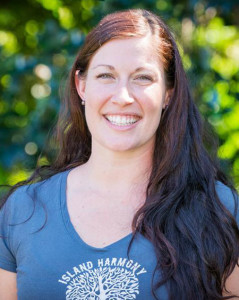By: Danielle Zandbergen, Therapist
“If the fires that burn innately inside our youths are not intentionally and lovingly added to the hearth of community, the youth will burn down the structures of the culture, just to feel the warmth.”
-Michael Meade
Before transitioning into the clinical team as a primary therapist, I began my journey at Pacific Quest as a program guide. I worked many weeks in the rite of passage portion of the program, Huli Ka’e, where our students step into a “threshold” experience and begin to “end their old story” and “begin stepping into the new story.” I’ve always viewed this phase similar to a metamorphosis or transformation that we often see in nature.

Danielle Zandbergen, MA
During one of my shifts in Huli Ka’e, I was working in the plant nursery with a student.While we were planting seeds together, we both noticed a cocoon on one of our growing papaya trees. We then began to bear witness to the cocoon cracking and opening up to a new life, as we watched the once known caterpillar morph into a beautiful monarch butterfly. As the student and I watched in awe, there was an intense emotion that welled up between us, to the point where we looked at one another silently and began to smile and cry at the sight of this rarely seen transformation. In so many ways, it was much like a student’s experience when participating in a rite of passage.
In grade school I remember learning about metamorphosis through the lens of a physical transformation many animals experience, where a caterpillar hatches from larva, then stuffs itself with leaves, grows plump and through a series of molts sheds its own skin. The caterpillar stops eating, hangs from a twig or leaf and spins a silky cocoon around itself and sometimes molts into a shiny chrysalis. It is then that the caterpillar experiences a radical transformation and eventually emerges as a butterfly. Tadpoles go through a similar transformation, where an egg mass is laid, cells grow into a tadpole, and the organism lives completely underwater, while a hormone in the tadpole’s thyroid gland initiates their metamorphosis. Then the tadpole develops into a frog, and all the organs and physical features transform in order for it to live outside of the water and learns how to adapt to a completely new environment.
Metamorphosis in the natural world is very much like the transformation our students experience as they embark on their own Rite of Passage, and in the grand scheme of things, what many of us experience throughout our lifetime. At Pacific Quest, we set the stage for a meaningful and transformative rite of passage that many teenagers never fully experience in their lives. Often named “liminality,” the threshold experience is paramount to the rite of passage and in a lot of ways, a student’s experience at Pacific Quest is seen as a “liminal” or threshold event. Liminality may involve a significant challenge, ambiguous features and sometimes disorientation between the “old and the new.” This often looks like a pattern that is no longer serving the individual, thus inducing a need to “sever from” and begin a transition into something new in order to get those needs met, or adapt to a new way of living.
 Our students often “stand at the threshold,” between the two worlds, in which we hold ceremony and ritual spaces to represent severance and incorporation. However, oftentimes a student needs to fully sever from certain behaviors, thought patterns or addictions in order to step into their new intention. Without this significant threshold experience, many teenagers and young adults seek various alternatives to mark this transition. Some resort to substances, buy lottery tickets or cigarettes, some engage in sexual activity, where some may engage in all of the above in order to feel as if they are stepping into their adulthood, but may not engage in the important ceremony and ritual that creates a meaningful experience for their transition.
Our students often “stand at the threshold,” between the two worlds, in which we hold ceremony and ritual spaces to represent severance and incorporation. However, oftentimes a student needs to fully sever from certain behaviors, thought patterns or addictions in order to step into their new intention. Without this significant threshold experience, many teenagers and young adults seek various alternatives to mark this transition. Some resort to substances, buy lottery tickets or cigarettes, some engage in sexual activity, where some may engage in all of the above in order to feel as if they are stepping into their adulthood, but may not engage in the important ceremony and ritual that creates a meaningful experience for their transition.
Although at first glance it may seem that these are unhealthy manifestations of a mental health issue, and subsequently may lead to even more unhealthy choices, there is also an element to these behaviors and choices that represent a child’s search for that threshold; signifying meaning and purpose in their lives. Our society tends to hold a lot of weight (and responsibility) over “ages,” such as turning 16 and being able to drive legally, or 18 when one is expected to move out, get a job, and continue college. Although all of these represent a form of rite of passage, over time they have come to be an expectation that has negated the entire meaning behind ceremony, ritual and celebration that is so much a part of a rite of passage.
One of our goals as a program is to facilitate and provide this experience to our adolescents and young adults. One of my goals as a therapist, guide, role model and caregiver, is to help our students find meaning in their life and recognize that what they are worth is only as much as they value themselves and their experiences in life. It is all of our jobs to celebrate these important marks of transition and develop intentional and positive ceremony around reaching these important life stages so the legacy can continue on.